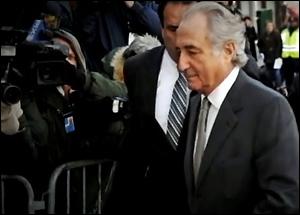By Pam Martens: January 9, 2014
According to the settlement documents released Tuesday by Preet Bharara, the U.S. Attorney for the Southern District of New York, Bernie Madoff was not content to simply engineer the largest Ponzi scheme under the very noses of the largest squad of regulators in the history of finance, he was simultaneously running a brazen check-kiting scheme under the same noses.
Irving Picard, the Trustee of the Madoff victims’ fund set up by the Securities Investor Protection Corporation (SIPC), provided a great amount of detail on this operation in a court filing against JPMorgan in 2011. This week, U.S. Attorney Bharara added additional details.
According to Bharara, Madoff was writing checks from an account at “Madoff Bank 2” – a bank other than JPMorgan – to Norman F. Levy, a mutual customer of both Madoff’s firm and JPMorgan. Later the same day, Madoff would transfer money from his primary business account at JPMorgan to his account at Madoff Bank 2 to cover the earlier check. In the final leg of the transaction, Levy would transfer funds from his own JPMorgan Chase account to Madoff’s primary business account at JPMorgan in an amount sufficient to cover Madoff’s original check to him.
Bharara does not mention Levy by name but it’s clear from Picard’s earlier filing that the client involved is Levy. Bharara also mentions in a footnote that this client died in September 2005, the date of Levy’s death at age 93. Levy was a Manhattan real estate broker and one of Madoff’s largest and oldest clients.
The Justice Department said “These round-trip transactions occurred on a virtually daily basis for a period of years, and were each in the amount of tens of millions of dollars. Because of the delay between when the transactions were credited and when they were cleared (referred to as the ‘float’), the effect of these transactions was to make Madoff’s balances…appear larger than they otherwise were, resulting in inflated interest payments to Madoff by JPMorgan Chase.”
Now comes the shocker: Bank 2 investigated these round-trip transactions, met with Madoff employees, and concluded there was “no legitimate business purpose for these transactions, which appeared to be a ‘check kiting’ scheme.” Bank 2 terminated its relationship with Madoff Securities and turned him in to the U.S. Treasury Department’s Financial Crimes Enforcement Network (FinCEN), along with details about the facilitating actions of Levy and JPMorgan Chase’s predecessor bank, Chase Manhattan.
To turn in Madoff, Bank 2’s employees filed a Suspicious Activity Report (SAR) with FinCEN. This would leave any experienced employee of a Wall Street bank or brokerage firm trembling in panic. The most famous case of check-kiting on the part of E.F. Hutton in the 1980s ended with the firm pleading guilty to 2,000 counts of mail and wire fraud and the end to the 80-year old storied firm.
But those JPMorgan folks are a tough bunch. According to Bharara, not only did the check-kiting continue but the dollar amounts increased, with the kiting occurring between accounts strictly within JPMorgan Chase. By December 2001, there was $6.8 billion in transactions in units of typically $90 million at a time. (What was really going on here has yet to be explained.)
Stephen Harbeck, the President of SIPC, may have inadvertently leaked the name of the mysterious Bank 2 in January 2011 when he responded to a series of questions in writing to Congressman Scott Garrett of New Jersey. According to Harbeck, there were only 11 banks where Madoff had established accounts which made transfers to and from the so-called “703” main Madoff business account at JPMorgan Chase or its predecessor banks. On that list, there is only one bank which stopped doing business with Madoff after a two year period — Bankers Trust. The letter also shows under the column titled “Purpose of Account,” that the Bankers Trust account was used to fund outflows to Madoff’s Investment Advisory clients.
We now know that in addition to multiple investigations by the Securities and Exchange Commission that went no where, the U.S. Treasury Department also failed to stop Madoff from defrauding customers for another decade.


